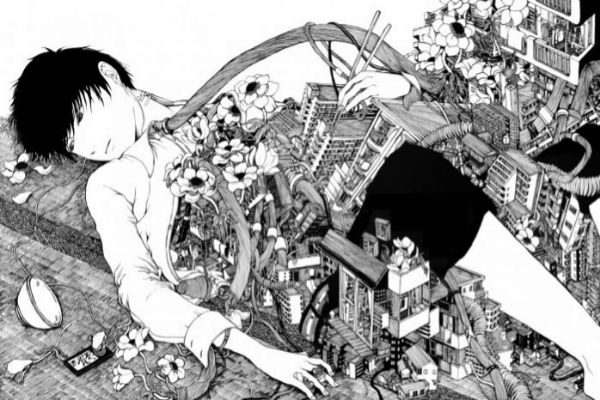- Sex and tentacles, this is the 'Miyazaki dark'
Incest, drugs, pedophilia and clandestine homosexual love between adolescents.A fragile adolescents, of androgynous beauty and angelic curls who come to prostitute themselves, all in the bucolic French countryside of the 19th century. These are the songs played by the ballad of the wind and the trees, a work by Keiko Takemiya that in the mid-70s revolutionized the manga scene in Japan and created a new genre: the yaoi or boys love, love stories between boys drawn by women and aimed at a female audience.
Against all odds, this widely normalized trend in Japan is taking hold on the European scene and, last year, the Milky Way publishing house published for the first time in Spanish this classic of the 70s, the decade in which women broke into the world of manga as authors and cartoonists. «Although they were readers, socially it was not clear that women drew manga. Its entry into the market was a great boom in women's manga, which until then had been limited to the topics of stories of orphans and dancers ... », explains the expert and translator Marc Bernabé, who has just published 501 manga to read in Spanish (Norma). And with them - who today outperform men as authors - came new themes, new ways of narrating. In fact, the origin of the Yaoi , "a genre that in the West has been difficult to understand," notes Barnabas, is in Europe: The ballad of the wind and trees is inspired by a film by the Nouvelle Vague, Les amitiés particulières , on relationships homosexuals in a boarding school. And the seminal Balada has passed to a whole stream that in Spain has also found its niche, with titles such as Color Recipe de Harada - nickname after which the author hides - which contains explicit scenes of hard porn and that Norma has Edited without Japanese censorship. Smaller publishers such as Tomodomo have specialized in shojo (stories for girls) and have paid special attention to boys love.
The unexpected interest of this subgenre has led Planet - which has the license of the three best-selling manga in the world: Dragon Ball, Naruro and One Piece - to look for new genres beyond the commercial. In a risky strategy, this year has been launched fully towards the yuri (lesbian loves) with the publication of five different titles, from Girl Friends to Bloom into you. «A decade ago it would have been unthinkable. But the variety of genres in the market is growing. We could stay quietly with the big licenses but we want to bet on new things. Shojo readers have grown up and ask for deeper and more sophisticated stories. Within the yuri opens a very wide range, with more complex funds and plots, ”considers the director of Planet Comics, David Hernando.
All trends are displayed in the XXV Salón del Manga in Barcelona, which opens today, becoming a true showcase of Japanese culture. "The world of manga is extremely wide, with dozens of trends and subgenres: documentary, educational, sports, political ... In Spain more and more news are published and foundational classics are recovered," adds Marc Bernabé. From rescuing teachers like Osamu Tezuka - to whom the National Museum of Art of Catalonia dedicates the first exhibition he organizes about manga - to the edition of the most bizarre genres such as eroguro (grotesque eroticism), which has its greatest exponents in Shuehiro Maruo and Shintaro Kago, radical authors whose violent work, often repulsive and of an explicit gore is not suitable for all stomachs. “Even in Japan, someone like Shintaro Kago is a minority: he sells more abroad than in his country. The relative success of the eroguro in the West is explained because it reaches the readers of alternative comics, not strictly manga, who are interested in the radical and experimentation of the Japanese, ”says Bernabé. An example: beyond the viscera, Kago is a virtuoso of comic architecture (and is published by ECC, the branch of DC Comics in Spain).
Within the framework of the eroguro , the forerunner of the hentai (manga porn) Toshio Maeda, champion of the so-called shokushu zeme or tentacle rape, stands out. Tentacles that were the resource to escape from Japanese censorship, which forbids drawing genitals (they must be blurred or pixelated). His summit work Urotsukidoji (1989) was published in Spain only three years ago, but in the early 1990s an anime version arrived on VHS that struck all of Europe for the explicit sex between girls and the tentacles of monstrous beings (in the background , the classic fight of good against evil). And it became a myth. Although its roots go back to the shunga tradition (erotic prints) and the engraving of Hokusai The dream of the fisherman's wife, the fantasy of a woman penetrated by two octopuses.
According to the criteria of The Trust Project
Know more- Spain
- Japan
- Europe
Mind Why do we Spaniards think we are the most unhappy in Europe?
30th anniversary. TenisRafa Nadal: "More than 'Marca España', I feel Spanish citizen, a lucky to be born where I was born"
Monetary policy Bad times for saving: 150,000 million have left Europe in just three years

